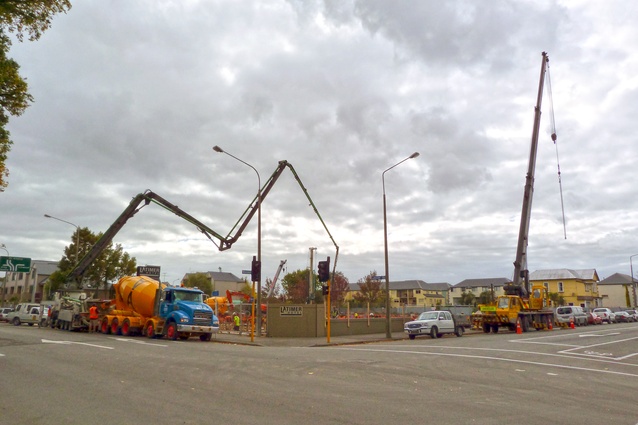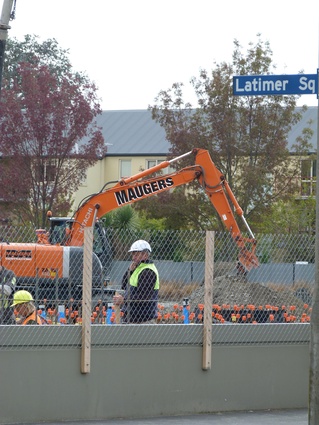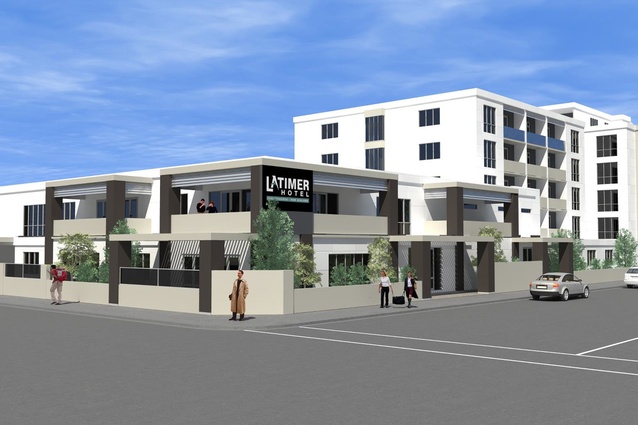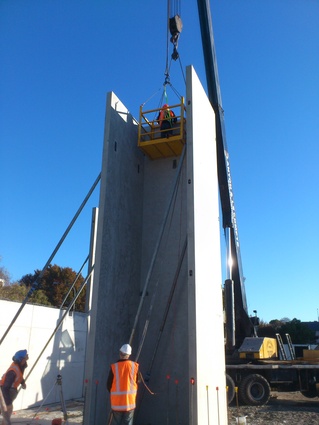Latimer Hotel - first on the block
The Latimer Hotel is one of the first high-profile rebuild projects in Christchurch. The building will overlook Latimer Square, which has become a focus for post-quake activity in the city.
In Christchurch, what happens underground is very important.
The $25 million rebuild of the Latimer Hotel in central Christchurch is a case in point. It took weeks of work and millions of dollars before the building started to come out of the ground. The building’s hefty foundations are one of the many ways the project has been shaped by the unique forces and pressures of post-earthquake Christchurch.
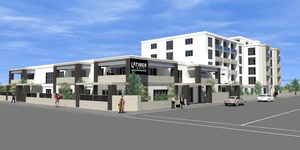
Insurance stresses, safety concerns, design expectations, urgency and location have all impacted on how the hotel is being built and how it will finally look. When the hotel was originally built in 1969 it had just 17 rooms.
Over the decades, the hotel slowly grew until it was a linked cluster of five buildings with 127 rooms. In the February quake, the hotel “pulled itself apart” as the different structures were repeatedly smashed together. The damage made the hotel uneconomic to repair, so it was demolished late last year. The new hotel has been designed to make sure that never happens again.
The two parts of the L-shape plan have a ‘seismic gap’ between them at foundation level. This gap will allow the two structures to move without crashing into each other, says site office manager and former Latimer Hotel duty manager, Kirk McDonnell.
“What happened in the previous quakes was different parts of the building were banging together and that caused most of the damage,” says Kirk. “These designs will take a lot of that stress out.”
The Latimer Hotel is one of the first high-profile rebuild projects in the city. The building will overlook Latimer Square, which has become a focus for post-quake activity in the city. The hotel will be neighbours with a temporary, cardboard cathedral designed by internationally renowned architect Shigeru Ban that the Anglican diocese are planning. Nearby a couple of high-profile businesses have reopened on the fringe of the city centre red zone.
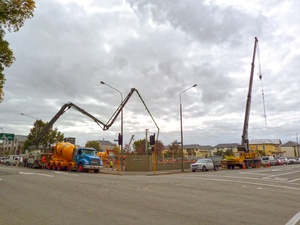
Latimer Square also has a resonance in Christchurch as a place where many gathered after the February 2011 quake. The square was also used as a field hospital to help the injured being pulled out the rubble of the collapsed CTV building across the road. The square’s local significance was acknowledged when it was chosen as the location for a big government announcement on the Christchurch rebuild plans recently.
Quake minister Gerry Brownlee made his announcement with the Latimer Hotel rebuild as his backdrop. It was clearly chosen to send a message that the rebuild was underway. But, when the announcement was made, very little could be seen coming out of the ground behind Brownlee.
The foundations were still being built. The foundations for the Latimer Hotel rebuild were an epic undertaking that took about 14 weeks to complete, consumed about a third of the budget and required about 900 cubic metres of concrete. The foundation work started in late January with the construction of 225 piles. The 17.5 metre deep, 750mm diameter piles took five weeks to complete and were constructed by drilling the holes, then filling them with concrete and inserting steel reinforcement frames before the concrete set.
A large steel-reinforced concrete raft was built on top of the piles. A 150mm concrete base was poured, then an 800mm steel frame was built in situ on top of that and set in concrete. Setting the steel frame in concrete required about 900 cubic metres of concrete. It was completed in three separate pours, including two pours that took about ten hours.
Kirk says the foundations were an expensive undertaking. “To just get above the ground cost us millions of dollars.” The foundations will bring the building up to 130 per cent of the new building code passed in Christchurch after the February quake.

Hotel owner Peter Knight hopes the strong foundations will make financial sense. In a city where insurance costs have skyrocketed, he hopes the extra seismic resistance will mean he gets a cheaper rate from his insurer.
“We just wanted to have a really safe building. With insurance it is all about risk and if you have things like sprinklers you get a better rate on your insurance,” says Peter. “There is very little risk here. Your money is pretty safe. That is the result of the whole project.”
Kirks says the sturdy foundations will also help keep the business running in the event of another quake. The hotel lost money after the September 2010 quake burst water pipes in the building and took about a dozen rooms out of action. “We had to completely redo them. Having those rooms out of action cost us.
“We wanted the building to be as safe as possible and as quake proof as possible. If we have another quake it is all down time while it gets inspected and we have the repairs done.
“We wanted to go past the recommended minimum for the building code so if we have another quake there will be the least amount of rebuild and repair.”
Peter says the extra measures will also give international visitors more confidence. “We wanted a safe building. Being an international hotel, people were really concerned about their safety.”
The immense concrete foundations were completed in mid-May. On top of them a simple steel frame and tilt slab structure is now being constructed. Knight chose tilt slab for one simple reason – speed. Peter’s business interruption insurance has run out so he needs to get trading again as soon as possible. “It has got to happen in a hurry because our business interruption insurance has ended and we are bleeding to death.”
Kirk agrees. “We chose tilt slab because it is fast. When it comes to building, the quicker it goes up the cheaper it is. The manpower drains the budget really fast.
“We need to get up and running as fast as we can.”
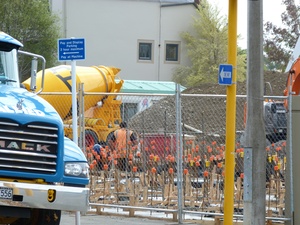
A restaurant, bar and a 700sq m conference space will open at the front of the site in November. Rooms will start to become available in February and the complete rebuild will be complete in May next year.
The way the building will look when it is finally completed has also been influenced by the unique pressures of post-quake Christchurch. The Christchurch City Council has placed a greater emphasis on design quality in the draft central city plan, the document that city leaders hope will guide the rebuild. A council urban design panel, established before the quake, recommended a series of design changes for the building.
The building was originally four-storeys at the Latimer Square front, with a seven-storey tower at the back of the site. The design now staggers the height from two-storeys at the front, four-storeys behind and five-storeys behind that. Kirk said the design process was an extra expense.
“We went through 12 different rewrites on that one,” he says. “It wasn’t cheap. Every time we do a redesign it is expensive.
“The city plan wants Christchurch to look prettier than it was. We had to sort things out.”
In many ways, the Latimer Hotel rebuild is a trailblazer for other projects that will start to come out the ground over the next year.
Kirk is confident Latimer Square will be a busy hub of activity once Christchurch begins to recover.
“We are definitely the first one on the block, but there will be a lot more happening around here.”

